
by Peter Boyles | Jan 30, 2017 | Blasting with Boyles
 As a little guy growing up with black and white television in Pittsburgh, I always thought the greatest thing on TV was professional wrestling. Today, as an old guy, I believe the greatest thing on TV is still professional wrestling.
As a little guy growing up with black and white television in Pittsburgh, I always thought the greatest thing on TV was professional wrestling. Today, as an old guy, I believe the greatest thing on TV is still professional wrestling.
I know all the news that I get — like Archie Bunker — comes from the National Enquirer, and the only real sport left is professional wrestling.
As a highlight of my life, as a young boy, disc jockey and a professional wrestling fan, I reached out to then local professional wrestling promoter the late Gene Reed, to see if I could get any professional wrestlers to appear on my show when they were in town.
I was the mid-day guy at the now defunct KAAT radio and hosted a mid-day show from the Yum-Yum Tree, a big barn like affair with restaurants inside, and lo and behold I got to interview the man I later found out owned the whole wrestling company, the late, great Verne Gagne. At that point, I could have died happy. You see, I was then officially called a “mark.” Wait, but what is a mark you ask? A mark is a person who believes professional wrestling matches are real. Some historians believe that the term dates back to a carnival term, when carnies would put chalk marks on a guy’s back so he was marked. And others would call a mark, a sucker. Other people believe it’s called hitting the mark which is a scam aimed at a sucker. And when it works, they hit the mark.
It’s the term that pro wrestlers and promoters use for people who buy tickets. Remember, these people are not considered fans or followers, they are simply marks. The wrestlers are only concerned with being paid, smirk at the marks, and when I finally got to do my first job as a ring announcer at Denver’s old Auditorium Arena, a couple of the guys and Verne “smartened me up.” Now I was on the inside and no longer a mark.
What strikes me now is how many people are marking for Barak Obama, George W. Bush, John Hickenlooper, Michael Hancock, The Denver Post, local news stations, and any politician that they think cares about them or their families.
Pro wrestling has two principal terms, one is called a “work” and the other is called a “shoot.” A shoot is real and everything else is a work. I am beginning to believe that Donald Trump became our president in a shoot and everything else is a work. Hancock’s and Hickenlooper’s Road Home is a work, George Bush’s war in Iraq was the biggest work of all time. Barak Obama’s life story is a total work. Are you starting to see the idea?
Sometimes the “boys” (what wrestlers call each other) use the term “smarks,” which is even more derogatory because they can point at you and call you that and you have no idea they are marking you. Another great pro wrestling term is called “selling.” Selling is to act as though you have been on the receiving end of a real fighting maneuver. The Denver Post leads the league. They have been selling for all of the above for so long they have no idea where real ends and work begins. Another term is called a “squash,” a huge mismatch where some heel (bad guy) takes some little face (good guy) and beats him up on TV. Everybody is selling, everybody is marking and no one is shooting. Now you understand the Train to the Plane. Another great term from the business, is called “switch the heat” or “pass the blame.”
And last, but not least, you have “workers” and a term called “work rate.” Those are both positive terms. It’s the pace of a match and the skill level of the wrestler. Ask yourself for real, how many real workers are in Front Range media and politics? I leave you with one more term that I was told about, it was the greatest definition for a wrestling match I had ever heard. It’s called a “Broadway.” It’s one hour long, everybody works very hard and it ends up a draw and they are rare and far between. We haven’t seen a full Broadway in this city for a long ass time. Andre the Giant was not 7’4”. But what the hell. Michael Hancock never bought a hooker. Ring the bell.
— Peter
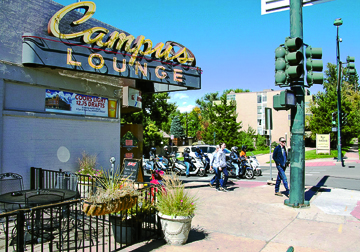
by Mark Smiley | Dec 22, 2016 | General Featured
$500,000 In Renovations But The Name, Sign, Bar And Booths Stay

 Home to an eatery since 1946, the corner of Exposition and University first opened as the Bel-Air and switched names to the Campus Lounge in 1949. Former Denver University and NHL hockey player Jim Wiste bought the business and real estate in 1976. The restaurant is expected to reopen as early as this month under new ownership.
Home to an eatery since 1946, the corner of Exposition and University first opened as the Bel-Air and switched names to the Campus Lounge in 1949. Former Denver University and NHL hockey player Jim Wiste bought the business and real estate in 1976. The restaurant is expected to reopen as early as this month under new ownership.
The sale of the Bonnie Brae landmark restaurant was announced to much fanfare with the last day of operation under the old ownership on September 25, but everything since that event has been shrouded in mystery, including who actually bought the business.
It was initially announced that a partnership led by St. Charles Town Company headed up by its president Charlie Woolley had acquired the Campus Lounge property along with fiction writer and vegan restaurateur Dan Landes. But a check of the real estate records by the Colorado Real Estate Journal showed that the property was, in fact, acquired by Exposition Avenue Properties LLC for $1.9 million with that entity headed by Wayne E. Barrett. Barrett is a vice president of ProLogic now headquartered in San Francisco but based in Denver until 2011.
“Wayne is an industrial real estate rock star,” Woolley told the Real Estate Journal. Barrett had hoped to remain anonymous in the Campus Lounge deal, Woolley explained. Furthermore, we’re told that Barrett is Woolley’s partner in another iconic restaurant, Wazee Lounge & Supper Club. Woolley bought the Wazee in 1997 but previously hadn’t disclosed Barrett was his partner. Since 1974 the Wazee Supper Club has been a landmark restaurant in Denver’s historic Lower Downtown district. Located at the intersection of 15th and Wazee Streets, it was founded by Angelo and Jim Karagas of My Brothers Bar fame.
In the case of Bonnie Brae’s Campus Lounge, Barrett had already put the deal together when he called Woolley to participate in it. “He really likes these cool, iconic places,” Woolley told the Colorado Real Estate Journal of Barrett. “He has a real passion for them.”
But they needed someone to actually run the restaurant. Woolley was then introduced to Landes by Todd Colletti, owner of the Buckhorn Exchange. The storied steakhouse — Denver’s oldest restaurant — is where mounted game gaze on dishes of yak, ostrich, elk and Rocky Mountain oysters.
The More Things Change — The More They Remain the Same
Opening under the same name — possibly as early as this month — the Campus Lounge is keeping the horseshoe bar, the booths plus the Campus Lounge sign. To continue the legacy of the Bonnie Brae eatery, the new owner is spending approximately $500,000 on renovation.
Woolley says the eatery will pay homage to the car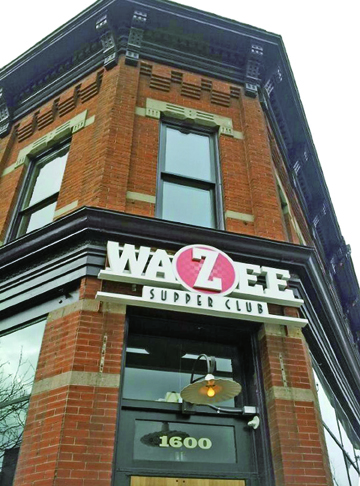 efree ambiance Jim Wiste created for the generation of families, patrons, and friends who frequented his beloved lounge.
efree ambiance Jim Wiste created for the generation of families, patrons, and friends who frequented his beloved lounge.
Landes’ vegan restaurant City O’ City is doing well in Capitol Hill, and Landes reportedly wasn’t looking for another restaurant but the Campus Lounge seemed too good to overlook. “It’s got all of the elements — the right neighborhood and a big kitchen — to get a return on investment,” he believes.
Meet Campus Suspect
Landes’ reputation as a Denver touchstone began as a restaurateur when he founded WaterCourse Foods in 1998 and City, O’ City in 2006. His other lifelong passion is for literature that is always brewing just beneath the surface. In 2012 he released his debut novel, Joonie and the Great Harbinger Stampede, a creation myth about the birth of consciousness, told through the lives of prairie animals. He sta rted his own publishing company, Suspect Press, in 2013 along with Brian Polk and Ken Arkind, and has published several of his own works since then.
rted his own publishing company, Suspect Press, in 2013 along with Brian Polk and Ken Arkind, and has published several of his own works since then.
The old Campus Lounge was famous for its burritos, burgers and beer. What the new menu will be is not yet revealed, but you can expect a full review of the revived restaurant in the next issue of the Glendale Cherry Creek Chronicle.
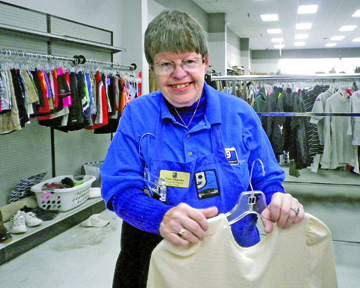
by Mark Smiley | Dec 22, 2016 | Travel
by Ruthy Wexler
 In a corner of the Goodwill Thrift Store in Glendale, employee Nancy Thurman plucks a pink sweatshirt from a shopping cart piled with clothing. First she tests the zipper. Then she bends to scrutinize the material. “I am looking to see if there’s a big tear,” she explains. “Or if it has a button missing. Or if it’s dirty.”
In a corner of the Goodwill Thrift Store in Glendale, employee Nancy Thurman plucks a pink sweatshirt from a shopping cart piled with clothing. First she tests the zipper. Then she bends to scrutinize the material. “I am looking to see if there’s a big tear,” she explains. “Or if it has a button missing. Or if it’s dirty.”
The shirt passes muster. “I’m zipping it up so it won’t fall off the hanger,” Nancy states, brown eyes proud of knowledge gained from experience. Then she goes to get another item from the overflowing cart.
Nancy is 70-years-old. This past July, she celebrated her 50th anniversary with Goodwill. You might jump to the conclusion that she never again wants to see one more pink sweatshirt. But from all accounts, working at Goodwill is the happy center of Nancy’s life.
The youngest of three sisters, Nancy was born in an era when families did not talk about having a “special child.” Nancy’s oldest sibling Lynne reflects on Nancy’s luck at being born to their particular parents. “My mother’s philosophy was: ‘We created a beautiful little bird and we will let it fly.’”
There was no mainstreaming back then; her parents enrolled Nancy in the Developmental classes at Wyman Elementary and East High School. “Growing up,” Lynne recalls, “we got involved with people in Nancy’s various classes. We saw how they were not allowed to be open to possibilities. My parents could have kept her in a safe little bubble. But instead they said, ‘Let her live.’”
Nancy began with love and acceptance. Still, research has shown that happiness comes from finding purpose in life. “Happiness cannot be pursued; it must ensue,” goes the famous quote from Victor Frankl. So in Nancy’s senior year, when she interned for Goodwill, then got a job there upon graduation — it seemed an extremely lucky break.
Except … for Goodwill, this was business as usual.
“It is our mission, it’s what we do, help people who face what we call ‘barriers to employment’,” says Vanessa Clark, Senior Director of Marketing at Goodwill Industries of Denver. “We have lots of folks just like Nancy. In lots of ways, her story is not unique.”
Goodwill Industries of Denver separates people who encounter “barriers to employment” into three groups — at risk students, struggling adults and families, individuals with disabilities — and provides programs to serve them. “All the programs are work force development in nature,” Clark explains. “It is all about helping people take care of themselves.”
Goodwill provides a variety of services for both intellectual and developmental disabilities; e.g., workshops in American Sign Language, training individuals to fix donated bicycles and electronics, facility based day programs.
So the clothing and coffee pots we see are just a tip of the iceberg?
“Yes,” smiles Clark. “This is our funding model: get donations, sell those donations through retail stores, and through the proceeds, fund our programs. All that clothing is processed by donation attendants, who are simultaneously learning organizational and other life skills.”
When Teshe Shimeles worked as a donation attendant, the life skill he learned was fluent English. As an ambitious 26-year-old in Ethiopia, Teshe won his DV (Diversity Visa) through a lottery; upon arriving in Denver in 2001, he was guided by his sponsor to Goodwill. Fourteen years later, he is manager (and has been for over a decade) of the Glendale Goodwill, supervising 44 employees, including Nancy Thurman.
“Seriously … Nancy is the best worker,” Teshe says. “Never late. Never forgets anything. We call her the Governor of Shoes.”
The story goes that, a few years back, when Nancy’s job was organizing the store’s shoes, she confounded everyone by finding a mate for every single shoe. “At the end of the day,” Teshe recalls, “she knew exactly how many white pairs,  how many brown …”
how many brown …”
As a child, Nancy was presented with a confusing array of cognitive limitations and physical difficulties. For a while, the family thought her diagnosis might be Savant (think Rain Man with Dustin Hoffman). “She’s always the scorekeeper when we play Yahtzee,” Lynne says, laughing. “My sister and I are college graduates but even before we begin adding up the numbers, Nancy’s done. And she’s always right.”
Despite her arithmetic facility, Nancy needs her family’s help to live independently. She sees them often, plays hide and seek with the little ones at family gatherings. “Everyone loves Aunt Nancy,” Lynn says. “She’s a character.”
But she’s something else, too: an important person at work. Co-workers appreciate Nancy’s willingness to help out wherever needed. They kid her affectionately about her love for the Broncos. When she was younger, Nancy was part of a circle of friends from Goodwill who went out together. “But those people were older and they’ve died,” Lynne relates. “Now, she feels so good about coming into work. She feels she has friends here.”
Does she ever get tired of working?
“No, I don’t get tired. Am I not the Governor of Shoes?” Nancy answers. She says proudly, “Teshe tells me, ‘I don’t know what we’ll do when you’re gone.’”
“Goodwill has given Nancy a sense of purpose,” Lynne observes. Then more quietly, “She has been molded by my parents … and by Goodwill.”
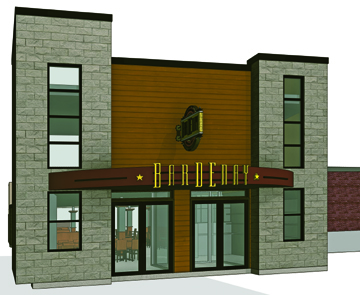
by Mark Smiley | Dec 22, 2016 | Main Articles
by Megan Carthel
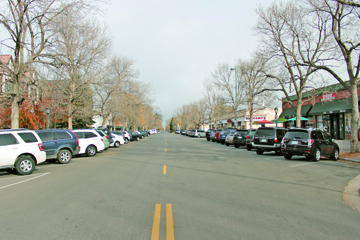 House Bill 15-1204 was signed into law on April 24, 2015, creating a Distillery Pub Alcohol Beverage License, and a man who had a large hand in the creation of that bill is opening a distillery pub in Park Hill, but not without some pushback.
House Bill 15-1204 was signed into law on April 24, 2015, creating a Distillery Pub Alcohol Beverage License, and a man who had a large hand in the creation of that bill is opening a distillery pub in Park Hill, but not without some pushback.
Kevin Settles, owner of Bardenay, a restaurant and distillery originating in Idaho, looked to expand to Colorado because of the beverage-friendly atmosphere and the soaring economy. But, much like Idaho used to be, Colorado did not allow for distillery pubs to operate, until last year.
Settles hired the lobbying group that got HB 15-1204 passed, lobbied himself and even helped write some of the verbiage, which includes that 15 percent of a brew pub’s gross income must be from restaurant food. Getting a Bill passed to open a business seems like hard work, and enough push-back for most, but Settles carried on, looking for a location along the front range that could house his business.
“A building that had ceilings approaching 20 feet in height and that was 6,000 feet, would’ve been the perfect building, but we couldn’t find it. We did find a space in Park Hill where we can work our way into that building,” Settles said.
That building currently sits vacant as it has for years, living previous lives as a movie theater and Korean church. Nestled on Kearney Str eet, the commercial block resembles the Gaylord or Wash Park neighborhoods with commercial streets with small restaurants, local businesses and a few condos. Some residents of the area think the quaint and quiet atmosphere will be disrupted by Bardenay going into the building, according to Marcin Biegunajtys, HOA president and owner of the condos next door to the proposed Bardenay.
eet, the commercial block resembles the Gaylord or Wash Park neighborhoods with commercial streets with small restaurants, local businesses and a few condos. Some residents of the area think the quaint and quiet atmosphere will be disrupted by Bardenay going into the building, according to Marcin Biegunajtys, HOA president and owner of the condos next door to the proposed Bardenay.
“Everything about it scares me, from traffic, from increased activity which is going to potentially cause more car theft, any number of things, to drunk driving,” Biegunajtys said.
The block has 70 parking spots with residential street parking surrounding the area. Settles said his restaurant and distillery is proposed to have 226 seats with about 20 employees on shift at a time.
While those for the business have left many positive reviews on social media sites like Facebook and Nextdoor, the opposition has been very vocal, posting anonymous fliers and writing a letter to the editor in The Denver Post and colle cting 138 signatures for a petition that calls for the restaurant distillery to be no more than 125 seats, 25 percent larger than the neighborhood’s largest restaurant, according to the petition, and a commitment to off-street parking solutions for at least 50 percent of its driving guests.
cting 138 signatures for a petition that calls for the restaurant distillery to be no more than 125 seats, 25 percent larger than the neighborhood’s largest restaurant, according to the petition, and a commitment to off-street parking solutions for at least 50 percent of its driving guests.
Diana Buirski, Park Hill resident, said many of her neighbors signed initial polling documents from a third party polling firm attorneys for Bardenay hired. Later some neighbors regretted signing, not knowing the true size of the establishment. According to neighborhood hearing documents, the polling company Bardenay hired acquired 148 signatures.
“What I’m hearing in Denver is nothing compared to what I got in Idaho because they are anti-alcohol,” Settles said.
In addition to parking, those who oppose th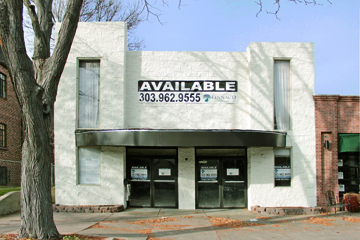 e current Bardenay proposal are worried about drunk driving, as the location is near a middle school and gymnastics gym. Marianne Rinehart, Park Hill resident and E.R. nurse, is particularly concerned about drunk driving and said “safe serve” is not enough to keep drunks off the street.
e current Bardenay proposal are worried about drunk driving, as the location is near a middle school and gymnastics gym. Marianne Rinehart, Park Hill resident and E.R. nurse, is particularly concerned about drunk driving and said “safe serve” is not enough to keep drunks off the street.
“That doesn’t work,” Rinehart said. “I work at University [hospital]. We see 300 patients a day. You have people who come that are drunk drivers that think they are fine — that they’ve had three drinks. I mean, the stuff that I’ve seen is just … you can’t look at someone and say that person is okay.”
Settles said his business has a “tremendous” reputation in Idaho.
“Based on 17 years in the business, I don’t think we’re going to have the problems the neighbors are worried about,” Settles said. “We’re not a noisy joint. We’re not a drunks’ bar. We’ve never had an infraction against our liquor license. We never over-serve.”
Todd Johnson, part owner of the building, grew up in Park Hill and said he would not put a tenant in his building that would harm the neighborhood. Johnson said the space is large and has high ceilings in the back, perfect for a brewery or distillery, in fact many of the potential tenants were breweries, but Johnson felt the neighborhood needed something more unique.
“I’m very excited for Park Hill. We were very selective on having a tenant that would be a very positive business that would be creative to the lifestyle and property values and all together be a benefit to Park Hill. I care about that as a former Park Hill resident and as a son of folks that live two blocks away on Kearney Street,” Johnson said.
Tommy Gilhooly, former owner of Oblio’s Pizzeria and Park Hill resident, said this type of pushback is familiar to him.
“I also had some pushback when I became the sole owner … and applied for the full liquor license,” Gilhooly said. “We had some local neighbors that were concerned. It’s pretty crazy how history is repeating itself because the concerns that are being voiced now like parking, like crowding, people getting in their car and driving drunk from a community establishment, those were concerns that were voiced about our liquor license application about 10 years ago, and none of it came to fruition.”
The neighbors said they are excited about a new restaurant going in the building, but the size of the establishment is the main issue, and they are hoping to work together across the aisle to create a perfect fit for the neighborhood.
“Initially when I heard there was a restaurant moving in I was all for it. I was all for having something there, not a 240 seat distillery,” Rinehart said.
“We’re proposing that we work together on a scale that’s more appropriate to the district and no one is suggesting that they don’t open or that we don’t want development, no one wants a vacant building either, that raises safety concerns too,” Buirs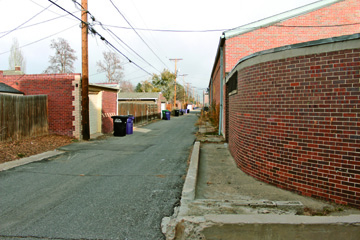 ki said. “I think to have something the size of a Chili’s [with no onsite parking] suddenly on a one-block neighborhood retail area, I just don’t see how they’ll do it without everything else having to change to fit that.”
ki said. “I think to have something the size of a Chili’s [with no onsite parking] suddenly on a one-block neighborhood retail area, I just don’t see how they’ll do it without everything else having to change to fit that.”
Still waiting on some permits, Settles said his casual restaurant distillery is “possibly close, but not a done deal.”

 As a little guy growing up with black and white television in Pittsburgh, I always thought the greatest thing on TV was professional wrestling. Today, as an old guy, I believe the greatest thing on TV is still professional wrestling.
As a little guy growing up with black and white television in Pittsburgh, I always thought the greatest thing on TV was professional wrestling. Today, as an old guy, I believe the greatest thing on TV is still professional wrestling.












